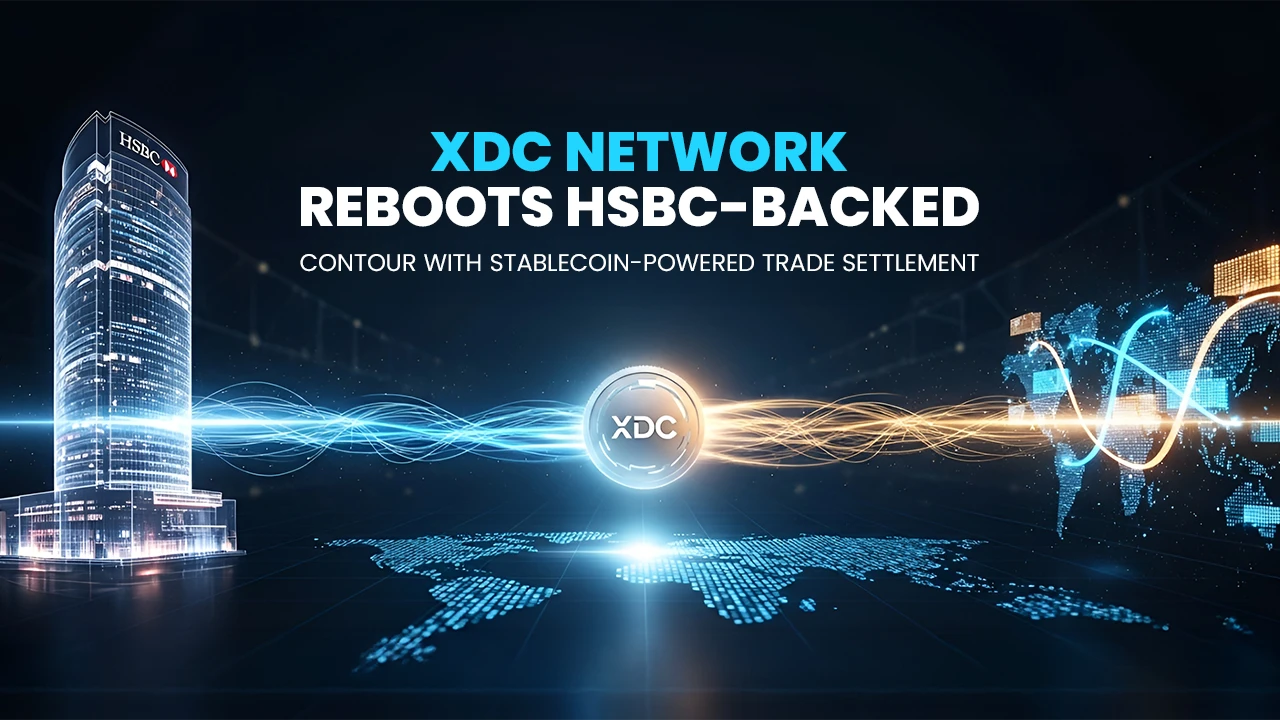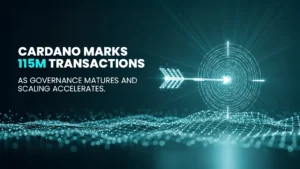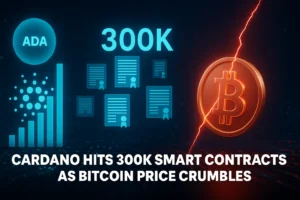XDC Network Acquires Former HSBC TradeFi Platform, Signals Major Shift in Institutional Blockchain Adoption

XDC Ventures, the investment arm of the XDC Network, has acquired Contour Network, a digital trade-finance platform once backed by HSBC, Standard Chartered, BNP Paribas, Citi, DBS, ING, Bangkok Bank, and CTBC. The deal revives a system that cut letter-of-credit processing from days to hours in pilots, then stalled after funding dried up.
- What Changed Today For XDC Network: The Deal and the Bank Footprint
- From Pilots to Production: Why Trade Finance Needs a Reset
- Inside the Plan: Contour 2.0 and the Stablecoin Lab
- The Rails: DPoS, TradeTrust, and Compliance-First Design
- Lessons From the First Wave: Why This Attempt May Land Differently
- Market and Investor Angle: What This Could Unlock, and What to Price In
- What Makes This Attempt Different: A Working Legal-Tech Stack
- Data Point Check: How Prior Pilots Performed
- Competitive Landscape: Risks and Realities
- What to Monitor Over the Next Two Quarters
- Key Takeaways
- Frequently Asked Questions about XDC Network’s Acquisition of Contour
- How does this acquisition change Contour’s original model?
- Why is delegated proof of stake relevant to trade finance?
- Which banks were originally involved with Contour?
- What legal frameworks support electronic trade documents here?
- Is USDC already available on XDC?
- How does this differ from failed projects like we.trade or TradeLens?
XDC Network says it will relaunch Contour with fresh capital and a Stablecoin Lab focused on regulated settlement, an approach that leans on the network’s Delegated Proof of Stake (DPoS) consensus to deliver near-real-time, low-cost finality for banks and corporates.
The announcement lands as institutions revisit tokenization and compliant stablecoins for cross-border commerce. Circle’s USDC went live on XDC Network in September, creating a native payment rail for trade instruments. If XDC Network can pair Contour’s bank relationships with DPoS speed and MLETR-compliant document rails, it puts a fresh production path on the table for a sector that has wrestled with legacy paper, manual checks, and fragmented consortia.
ALSO READ: Cardano Hits Record 115M Transactions, Celebrates 8 Years of Steady Uptime, Usage
What Changed Today For XDC Network: The Deal and the Bank Footprint
CoinDesk confirmed the acquisition on Oct. 22, noting that Contour’s core product digitized letters of credit and had support from top global banks before it shuttered in late 2023. XDC Network plans to restructure the platform with new funding and a strategy centered on tokenized settlement and regulated stablecoins.
“Banks need settlement rails, treasury optimization, and compliance frameworks. We’re building all three,” said XDC Network co-founder Ritesh Kakkad.
XDC Network framed the move as a way to reconnect a proven, bank-tested workflow to public-chain settlement. Contour’s roots date to the Voltron initiative on R3’s Corda, which ran live pilots across 14 countries and reported up to 90% faster LC processing. Backers included HSBC, Standard Chartered, and BNP Paribas, among others, giving XDC Network a head start with institutions that already tested the rails.
XDC Ventures has acquired @contourtrade , the global blockchain platform for digitized Letters of Credit backed by major banks like HSBC, Standard Chartered & Citi.
Together, they’re launching a Stable-Coin Lab to revolutionize cross-border trade finance & real-world… pic.twitter.com/L6npIRjDxF
— XDC Network (@XDCNetwork) October 22, 2025
The acquisition also creates an aperture for a broader ecosystem. Yahoo Finance and The Defiant highlighted XDC Network’s plan to court strategic investors with compliance and risk credentials, while re-engaging banks that once funded the consortium. Early reporting places the emphasis on disciplined rollout rather than headline targets, a lesson learned from the first wave of trade-finance blockchains.
From Pilots to Production: Why Trade Finance Needs a Reset
Trade finance still relies on paper, manual compliance, and multi-jurisdictional handoffs. That friction causes cash cycles and creates fraud risks. Contour’s pilot results, along with documents from HSBC, DBS, Citi, and development banks, show how digital LCs can cut processing from a week or more to under a day.
The Asian Development Bank estimates a trade-finance gap of around the trillions, a structural shortfall that rewards any credible reduction in turnaround time and working-capital drag.
A DPoS chain like XDC Network is built for this kind of workflow. Its validators finalize blocks in seconds, with fees at a fraction of a cent and on-chain governance that includes slashing. That profile favors high-frequency document events and predictable settlement windows that banks can model. XDC Network describes its DPoS variant, XDPoS, as enterprise-ready due to self-KYC nominators and a hot-stuff BFT layer, a design that aims to balance speed and auditability.
Contour’s original pain point was not the LC process. It was scale and funding. GTR Review and Ledger Insights documented the shutdown after shareholders pulled support, even as efficiency metrics stayed strong. The reboot under a leaner ownership model, with a settlement rail that now includes native USDC on a DPoS network, addresses the two choke points that stopped the first act.
Inside the Plan: Contour 2.0 and the Stablecoin Lab
XDC Network will house a Stablecoin Lab within the restructured Contour program. The mandate is narrow: build enterprise pilots for bank-grade stablecoin settlement, treasury workflows, and LC payouts that respect compliance rules. CoinDesk and subsequent trade-tech outlets describe an initial focus on USDC, which is now live on XDC with Circle’s cross-chain transfer protocol CCTP for asset mobility between supported networks.
ALSO READ: 21Shares Amends Sui Staking ETF for Nasdaq, Market Responds with a 2.5% Surge
Stablecoin-settled LCs change the cash leg. Instead of separate correspondent banking hops, banks can move value on the same ledger that anchors documentary evidence. That reduces reconciliation work and narrows the time between presentation and payment. If pilots confirm durable cost savings and predictable finality, the model scales. It also gives banks a single set of controls to audit flows, align with travel-rule requirements, and manage exposure to tokenized trade receivables.
XDC Network’s DPoS consensus is the engine behind that proposition. Two-second blocks and fast finality cut operational latency. Low fees enable granular events, from status updates to partial draws, without budget shock. For banks, cost transparency matters as much as speed. The lab structure makes it easier to co-design controls with regulators and treasury teams before any wide launch.
The Rails: DPoS, TradeTrust, and Compliance-First Design
Institutional adoption hinges on more than throughput. Legal recognition and interoperability carry equal weight. XDC has integrated with Singapore’s TradeTrust, the government-backed framework that implements the UNCITRAL Model Law on Electronic Transferable Records. TradeTrust runs on public networks, including XDC Network, and provides a neutral way to verify, endorse, and transfer title for electronic bills of lading and other ETRs. That legal wrapper is a prerequisite for bank-funded trade assets.
XDC also highlights ISO 20022 messaging support and R3 Corda interoperability, both cited in the acquisition coverage, which can reduce integration work for banks with existing back-office pipes. Deutsche Telekom MMS operates an XDC masternode, a signal of infrastructure resilience that large institutions look for when mapping operational risk. Together, these hooks lower barriers that stalled prior networks.
This is where DPoS reappears as a positive. Delegation aligns validator incentives with stakeholders and enables on-chain governance controls, such as slashing, that can be tuned to institutional risk appetites. XDC Network positions its DPoS stack as both efficient and adaptable, a claim that will meet real-world scrutiny as pilots move from demo to daily volume.
Lessons From the First Wave: Why This Attempt May Land Differently
The first set of trade-finance consortia proved a point about technology and a second point about economics. We.trade shut in 2022 after failing to secure funding. Marco Polo entered insolvency in 2023 when a key investment fell through. TradeLens, the IBM-Maersk supply-chain platform, closed in 2023 for lack of commercial viability. Contour, the last bank-led LC network, shut a few months later despite strong pilot metrics. The pattern was clear: technology worked, the business model did not.
A useful comparison below highlights the backers, stacks, and status of the main projects as of October 2025.
| Network | Core use case | Tech base | Key backers | Current status | Primary cause cited |
| Contour | Letters of credit | R3 Corda | HSBC, Standard Chartered, BNP Paribas, Citi, DBS, ING, Bangkok Bank, CTBC | Acquired by XDC Ventures, Oct 22, 2025 | Funding and scale, now revived with a stablecoin settlement plan |
| we.trade | Open-account trade | IBM/Hyperledger | CaixaBank, Deutsche Bank, HSBC, KBC, Nordea, Rabobank, Santander, UBS, UniCredit | Shut, Jun 2022 | Ran out of funding |
| Marco Polo | Open-account trade | R3 Corda | Commerzbank, BNY Mellon, ING Ventures, BNP Paribas | Insolvent, Feb 2023 | Lost critical investment, failed to scale |
| TradeLens | Supply-chain docs | IBM/Hyperledger | Maersk, IBM | Discontinued, Q1 2023 | Commercial viability shortfall |
Post-mortems from senior insiders support that view. “I was sure Contour was the future,” said Joshua Kroeker, a creator of the project while at HSBC, who later argued that consortia chased network effects that required everyone to join at once.
The new wave favors modular rails, open standards, and business models that can earn revenue before full ecosystem convergence.
ALSO READ: XDC Network Unveils $10M “Surge”, Brings Real-Time Transparency to DeFi
Market and Investor Angle: What This Could Unlock, and What to Price In
Coverage of the acquisition from CoinDesk and Reuters’ wire partner feed frames the move as a bridge between tokenization, stablecoins, and regulated trade flows. The bank roster that tested Contour does not guarantee instant volume, but it matters for pilot pipelines. XDC’s partners, cited in the coverage, include Circle and Deutsche Telekom MMS. USDC is now native on XDC Network, and central venues have begun to support deposits and withdrawals, a prerequisite for live settlement experiments.
For investors, the near-term work is operational. Watch for LC pilots that use USDC on XDC Network for actual payouts, not just document exchange. Track how often banks reference MLETR-compliant instruments tied to TradeTrust, since legal enforceability drives balance-sheet comfort. DPoS finality and cents-level fees are necessary, but governance, identity, and reporting will decide whether pilots graduate to production at scale.
What Makes This Attempt Different: A Working Legal-Tech Stack
The restart leans on a stack that did not exist when the first consortia launched. TradeTrust now connects to XDC Network, Ethereum, and Polygon, creating a neutral pathway for electronic transferable records. XDC Trade Network rides that framework to issue, verify, and finance MLETR-compliant documents, including electronic bills of lading, with LEI support for counterparty checks. Those layers reduce legal ambiguity and shrink onboarding friction.
On the settlement side, native USDC and CCTP bring a regulated, widely integrated stablecoin into the workflow. That gives banks a way to test atomic delivery-versus-payment with audit trails, while keeping fiat redemption in scope at all times. If pilots pair DPoS finality with e-document title transfer under MLETR, trade assets can settle in minutes with clear legal standing, a tangible upgrade from early proofs that never closed the cash leg.
The institutional bench is also broader. Deutsche Telekom MMS operates an XDC masternode, and XDC Network cites ISO 20022 messaging and Corda interoperability. These choices align with bank-grade requirements for resilience, messaging, and coexistence with existing systems. Risk teams read those signals closely.
Data Point Check: How Prior Pilots Performed
Pilot results provide a floor for expectations. HSBC, DBS, and Citi each reported LC cycles falling from five to ten days to under 24 hours on Contour. Euromoney, The Asian Banker, and development-bank studies corroborated the 90% reduction figure. That gain does not vanish because a consortium dissolves. The question is whether a DPoS-plus-stablecoin design can lock in those gains and compound them through instantaneous settlement and standardized compliance.
The ADB’s multi-trillion-dollar trade-finance gap adds urgency. XDC Network’s model targets the spread between manual processing and programmable settlement, a spread that consumes balance-sheet capacity and working capital across supply chains. If the lab produces templates that regulators accept and banks reuse, the addressable flow is large.
Competitive Landscape: Risks and Realities
History cautions against grand claims. We.trade and Marco Polo struggled even with blue-chip backers. TradeLens had brand power and was still closed. DigFin’s look-back noted how consortia chased network effects and lost time before proving unit economics. XDC Network’s bets that a single L1 with DPoS finality, a legal-grade document layer, and a regulated stablecoin can remove enough friction to make the economics work. Execution will test that thesis.
Success depends on three proofs. First, bank pilots that go beyond demos to pay real suppliers with USDC on XDC, then redeem back to fiat. Second, repeatability across markets that already accept MLETR-compliant instruments. Third, evidence that DPoS governance can satisfy risk committees on uptime, slashing, and node diversity. Each proof has a timetable shorter than a credit cycle, which keeps the story measurable.
What to Monitor Over the Next Two Quarters
Track named bank pilots, geography, and instrument type. Letters of credit are the beachhead, but receivables, guarantees, and documentary collections offer follow-on volume. Watch for explicit mention of USDC settlement on XDC Network, CCTP usage for cross-chain movement, and TradeTrust-verified ETRs. Exchange support for USDC on XDC Network will help liquidity, but the critical data will be transaction counts, not token price moves.
Monitor policy signals. More MLETR adoptions or guidance on electronic bills of lading widens the lane for production use. The market has learned that regulation and standardization are not footnotes in this sector. They are the unlock. DPoS chains that demonstrate stable governance and robust compliance tooling will have a cleaner story to tell bank supervisors.
“By combining Contour’s global LC consortium with the XDC Network’s hybrid blockchain and Web3 ecosystem, we’re creating an institutional gateway for tokenized trade finance and cross-border settlement,” Khekade said. That statement sets the bar. The next press releases will show if banks agree with their wallets.
Key Takeaways
XDC Network’s headline moment is not only the Contour deal, it is the network’s ability to carry it. The consensus engine matters here. Delegated Proof of Stake (DPoS) gives XDC fast finality, predictable fees, and an accountability model that banks can evaluate. Rapid block times shorten document and payment handoffs, low transaction costs support granular events like partial draws and status updates, and on-chain governance with slashing aligns validator behavior with operational risk standards.
That profile turns a proven letter-of-credit workflow into a credible settlement pathway. Pair MLETR-recognized documents through TradeTrust with native USDC on XDC, then measure cycle time, reconciliation steps, and redemption reliability. If pilots show repeatable savings and clean audits, the economics support scale. If uptime and validator performance hold under real load, risk teams gain confidence in production use.
The acquisition sets the stage, but the consensus mechanism provides the rhythm. If results match the design, XDC’s Delegated Proof of Stake will be read as the quiet advantage that moved trade finance from demonstration to daily use.
Frequently Asked Questions about XDC Network’s Acquisition of Contour
How does this acquisition change Contour’s original model?
XDC Ventures is replacing a bank-funded consortium with a leaner ownership and a Stablecoin Lab that targets regulated settlement. The goal is to connect Contour’s LC workflow to on-chain payment rails and move from proof-of-concept cycles to repeatable production.
Why is delegated proof of stake relevant to trade finance?
DPoS finalizes blocks in seconds with low fees and on-chain governance, a fit for LC events that require predictable timing and audit trails. XDC’s XDPoS adds enterprise checks such as self-KYC for nominators and slashing, which can help address bank risk requirements.
Which banks were originally involved with Contour?
HSBC, Standard Chartered, BNP Paribas, Citi, DBS, ING, Bangkok Bank, and CTBC were among the backers. Their teams ran pilots and reported faster LC cycles, then withdrew funding in 2023, which led to the shutdown.
What legal frameworks support electronic trade documents here?
TradeTrust implements the UNCITRAL Model Law on Electronic Transferable Records and connects to public chains, including XDC. It enables verification and title transfer for electronic bills of lading and related documents.
Is USDC already available on XDC?
Yes. Circle launched native USDC and CCTP V2 on XDC on Sept. 17, 2025. Centralized exchanges have begun to add support for deposits and withdrawals.
How does this differ from failed projects like we.trade or TradeLens?
Those platforms proved efficiency, but could not align funding and network incentives. XDC’s approach adds a DPoS settlement rail, a regulated stablecoin, and MLETR-compliant document frameworks. The combination seeks commercial traction without requiring every party to join a single closed consortium.




